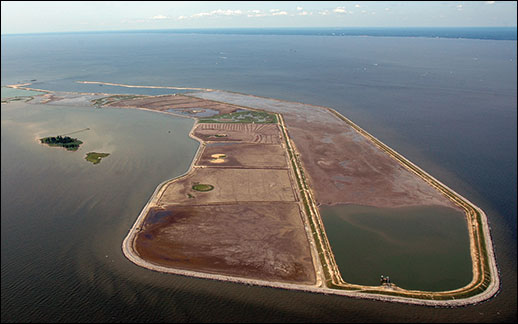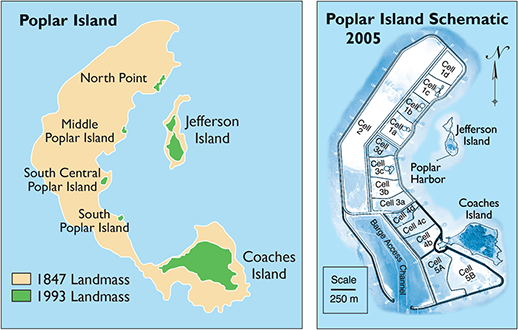|
An Island Rises . . . Again
October 2013 • Volume 12, Number 3

Credit: Jane Thomas
Jeffrey Brainard
 Poplar Island is an enormous artificial creation rising out of the Bay's waters, 3.5 miles long and a half-mile wide. To build it, workers placed sand, rock, and dredged sediment on the remains of the original Poplar Island, which had nearly disappeared during the previous century. This massive feat of engineering, begun in 1998, is a large-scale experiment to test solutions to several challenges facing the Bay. One is to create enough storage space to contain all of the sediment dredged from the Bay's cargo-shipping channels. Another challenge is to rebuild and restore small, low-lying islands in the Bay that have been eroded and submerged by rising sea level. Yet another challenge is to reverse the loss of natural marsh and wildlife habitat around the Chesapeake. Scientists are studying the engineered marshes on Poplar Island to see how they compare to natural marshes in taking up excess nutrients and giving a home to birds and other wildlife. more . . .
Over the course of one day’s visit, environmental consultant and long-time birder Jan Reese makes his way across Poplar Island from one diked section to the next, scanning the landscape. Since 2002 he has worked to count every bird and record its species name. So far, his figures have helped to show that bird populations there have vastly increased. more . . . |
On a June morning in 1950, along a deep-water creek near Annapolis, a scientist named Don Pritchard climbs aboard an 85-foot research vessel, lights his pipe and gives his crew the order to cast off for the southern reaches of Chesapeake Bay. His ship is the Joan Bar II, a converted motor yacht. His crew includes a ship's captain and several other scientists. Their mission: help figure out what forces were behind some mysterious booms and slumps in the harvests of oysters and blue crabs and finfish in the largest estuary in the country. more . . . |
A Tour of Poplar Island and Marsh Research
|